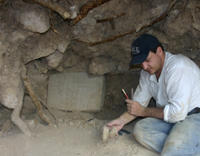Long-sought Maya City — Site Q — found in Guatemala
 | New Haven, Conn. -- A team of scientists including Marcello Canuto, professor of anthropology at Yale, has found incontrovertible proof of Site Q, a long-speculated Maya city, during a mission to the northwest Peten region of Guatemala |
The proof—an in-situ panel carved with over 140 hieroglyphs that fill in a key 30 year chapter in classic Maya history—was found in a little known ancient royal center called La Corona.
Roughly 40 years ago, the antiquities market was flooded with many exquisitely carved monuments of apparent Mayan origin. Many were purchased for private and museum collections despite a lack of provenance. Because of their similar style and shared subject matter, it was suggested that they came from some still unknown site located somewhere in the Peten lowlands. This site called Site Q — an abbreviation of the Spanish “ ¿que? ” or “ which? ” —has been the target of many expeditions.
The expedition to Guatemala this past April was to set up camp for an in-depth study later this year. On their last day in camp, Canuto and his team happened upon what they believe to be one of the monuments of Site Q.
“This panel exactly mirrors the style, size, subject matter, and historical chronology of the Site Q texts,” said Canuto. “This discovery, therefore, concludes one of the longest and widest hunts for a Maya city in the history of the discipline.”
In addition to confirming the existence and location of Site Q, the find is one of the longest hieroglyphic texts discovered in Guatemala in the last several decades. Canuto also noted that the two blocks making up the panel appeared to be in their original location in a temple platform and were in no way damaged or looted.
“The discovery reinforces the existence of a ‘royal road,’ a strategic overland route that links the Maya capital to its vassal kingdoms in the southern lowlands,” said team member David Freidel, professor of anthropology at Southern Methodist University. “For this reason, the forested enclave of Laguna del Tigre should receive serious consideration as a World Heritage Region.”
The group will be returning to Guatemala to continue the study, which was supported in part by the National Geographic Society, the El Perú-Waka’ Archaeological Project directed by David Freidel and Héctor Escobedo, and the Wildlife Conservation Society.
Other researchers included a mapping team of Damien Marken and Lia Tsesmeli, and an epigrapher Stanley Guenter, all of Southern Methodist University. Logistics for the expedition were carried out by Roan McNabb of the Wildlife Conservation Society, and Salvador Lopez, head of the department of Monumentos Prehispánicos of the Guatemalan Instituto de Antropologia e Historia (IDAEH). ###
Contact: Janet Rettig Emanuel janet.emanuel@yale.edu 203-432-2157 Yale University
more at Maya and Guatemala or hieroglyphs and Archaeological or Archaeology and science











No comments:
Post a Comment